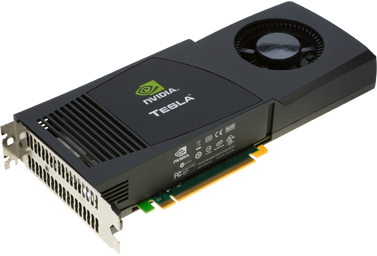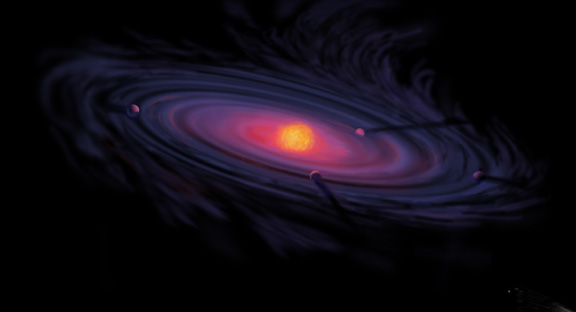|

Nvidia
TESLA-C1060
card
(240 CUDA cores)
PI:
Assist.
Prof. Kleomenis Tsiganis (AUTh)

|
Study
of planet formation process using high-resolution simulations
Project
# 89406, Research Committee AUTh (2013)

people
who collaborated:
Sotiris
Sotiriadis (MSc student)
Zsolt
Sandor (post-doc researcher, Un. of Vienna)
and
G.
Voyatzis (AUTh), A. Morbidelli (OCA/Nice)
|
Q:
How do planets and systems of planets form ?
Brief
Description of the Project
The
formation of planets and planetary systems of different types is an
extremely complex physical phenomenon. Understanding the processes
that govern planet formation requires the use of extensive,
high-resolution computer simulations, which translates to building
dedicated software and having immense computing power, not always
available (or extremely costly to develop). This can be overcome with
the use of general-purpose
Graphics Processing Units (gp-GPUs,
a.k.a. programmable graphics cards).
New-generation GPUs can turn a normal PC to a small super-computer at
a very low cost.
In
this project, we use GPU-based simulations to study planet formation
and the dynamical stability of planetary systems. We used our
GPU-based platform at the Lab. Of Mechanics, Dept. of Physics, AUTh:
2
Quad-core PCs equipped with 4x and 2x (resp.) Nvidia Tesla-C1060 GPU
boards – each with a ~1 Tflops performance for single-precision
arithmetic)
and developed the necessary software. This has been done with the
help of our collaborators (see above).
In
the following we present the technical/scientifc achievements of our
project, namely:
(a)
software
that has been developed (link to the code and a short manual is
included below),
(b)
results
from simulation of planet formation and dynamical evolution of
systems, and
(c)
relevant
scientific and educational material (papers/presentations)
Results
Software development
We have build a series of codes, based
on the well-established N-body code “SyMBA” (Lee et al.
2001). The new subroutines that we built were integrated in SyMBA and
tested, both on our GPU platform as well as on the newer Tesla –
K20 GPU platform at the Southwest Research Institute (SwRI, Boulder
CO, USA). The main new routines are responsible for:
performing the necessary O(N2)
force calculations at every step between N massive bodies on
a GPU. This has been implemented in different ways:
- using the SAPPORO library (i.e.
using sub-routines that are similar to those needed for GRAPEs):
symba_GPU_Sap
- using the OPEN_ACC protocol :
symba_openacc
- using CUDA/Fortran : symba_cuda
performing a nearest-neighbor
search (necessary for better resolving close encounters between
massive bodies in SyMBA) on the GPU. Again this has been implemented
both using CUDA/Fortran and OPEN_ACC
calculating the accelerations felt
by a massive body (or a small, test-particle) due to a massive gas
disk, present in the system. This includes tidal forces (leading to
Type I/Type II migration for planets and massive embryos) and drag
forces (Stokes and Epstein drag) for smaller particles (which are
considered not to be interacting with each other, gravitationally).
For the time-being this is included in standard SyMBA and in our
Sapporo-based GPU version (symba_drag).
An additional version of symba_GPU_Sap
has been developed, in which an additional (distant) stellar
perturber on a fixed elliptical orbit is considered. This code was
developed with the intention to be used for studying planet formation
in well-separated binary stars. It goes without saying that this
treatment is an approximation, since the binary orbit remains
unaffected by the gravitational perturbations that the planetary
embryos exert on the binary. The code has been tested by studying the
evolution of a proto-satellite disk around a planet, which itself
revolves on a fixed elliptical orbit around a star. An “extra”
feature is that the inclination of the orbit can change in time, with
respect to the planetary equator, so that we could study the
formation and dynamical evolution of satellites (or planets, in the
context of a binary star), while the spin axis of the central body is
changing in time (e.g. formation of the satellites of Uranus, during
the “event” that has tilted the planet's rotation axis by
98 deg, with respect to the orbit normal).
Some benchmarking of the codes is shown
below. Note that the GPU-based codes can be ~ 20 times faster in
execution that normal SyMBA (in one CPU), as shown in the graphs /
tables.
The codes can be found in the following
link, together a short user's manual.
Simulations
Here's a collection of some simulations
performed using these codes, on different problems in planet
formation and dynamical stability of planetary systems. These
include, (I) vertical stability of two-planet systems, (II) evolution
of a self-gravitating disk and the precession of embryo orbits
therein, and (III) formation of Earth-like planets and Giant planet
cores in a self-gravitating disk
I) First, let's start with the problem
of dynamical stability of an initially nearly co-planar two-planet
system and the possibility of forming a “3-D” system. It
is known that extrasolar systems exist, containing more than two
giant planets; in some of which a resonance relation between the
orbital periods of the planets exists (e.g. the outer planet takes
twice as long to go around the star as the inner one, i.e. they are
in a 2/1 orbital resonance). Previous studies have shown that such a
resonance can be established while the system is still forming, as
the gas disk forces the planets to migrate towards the star at
different rates. Then, when the period ratio becomes commensurate
(e.g. 2/1), the planets can enter a gravitational resonance, which
tries to maintain itself against migration. This leads to the
increase of orbital eccentricities; a well-known phenomenon in
planetary dynamics. The question we want to answer is whether it is
also possible for very small (less than 0.1 deg) deviations from a
co-plane configuration can be enhance by the resonance, so to produce
a system that will have a significant mutual inclination. This would
mean that the system of planets does not move on the same plane
anymore but, rather becomes a '3-D' system. This was shown to happen,
in previous works, for specific resonance combinations, but the
explanation was not clear.
As was shown before by our
collaborators, a stable two-planet system follows a resonant
trajectory that belongs to one of the families of resonant periodic
orbits, as shown below (these orbits can be found with accuracy,
using specialized algorithms). The interesting feature is that some
of these orbits can be shown to be vertically unstable, i.e. the
system can no longer stay on the original mean plane but has to have
a non-zero mutual inclination. What we need to understand is whether
gas-driven migration can force the system to move along the family of
resonant orbits, starting from a circular and co-planar
configuration, cross a vertically critical orbit and then become
'3-D'.
A series of simulations were performed
(using “symba_drag” and a similar code in C++), where
tidal (Type II) migration was included, in the form of a Stokes-type
drag (see …), assuming different values of the migration
parameters (i.e. migration rate and eccentricity damping rate) and
planetary masses. The systems generally behave as shown in the
results below
As seen in the graphs, the systems
indeed cross a vertical critical orbit (depending on the mass ratio),
if the eccentricity manages to grow beyond some value, during the
resonance capture. This leads to the formation of 3-D systems! Such
systems can exist in nature, if gas disks are not efficient in
damping the eccentricities of the planets. The eccentricity of the
critical orbit depends on the mass ratio and resonance considered, as
shown in the respective graph.
These results have been presented
in the “11th Hellenic Astronomical Conference”
in Athens, September 2013 (PDF presentation). A paper has been
submitted for publication in the international journal “Celestial
Mechanics and Dynamical Astronomy” (PDF).
II) A self-gravitating disk of gas and solid material is the
environment in which planets can form. Similarly, a gas-poor disk of
solids (of different sizes) is the outcome of planet formation. Such
a system will subsequently evolve dynamically, under the effects
(primarily) of self-gravity between its constituents (planets,
embryos, small planetesimals). It is therefore important to be able
to simulate effectively the gravitational interactions of at least
tens-hundreds of thousands of bodies. Note that this is still an
oversimplification (a “real” system will contain
thousands of relatively big objects, but also billions of small
bodies), but it's the best we can do so far.
It is known from analytical theories that the orbits of bodies in a
massive self-gravitating disk
III)


